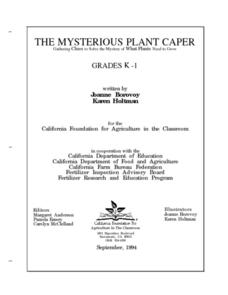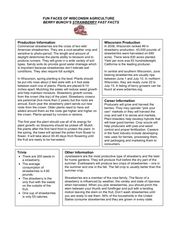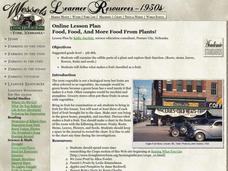Berkshire Museum
The Three Life-Giving Sisters: Plant Cultivation and Mohican Innovation
Children gain first-hand experience with Native American agriculture while investigating the life cycle of plants with this engaging experiment. Focusing on what the natives called the Three Sisters - corn, beans, and squash - young...
Curated OER
Learning the Parts of a Plant
First graders discover the anatomy of a plant by labeling a picture. For this botany lesson, 1st graders examine and dissect several real plants in class and define their different parts. Students utilize the Internet to view...
Curated OER
6: Parts of a Flower
Students draw and label the parts of a flower using a coin from the Northern Mariana Islands. In this flower parts lesson, students look at a transparency of the reverse side of a quarter from the Mariana lslands. They discuss the...
Curated OER
The Mysterious Plant Caper
Learners investigate the basic parts of plant and that plants are living things which require water, air, light and nutrients for survival. They do this through a series of scientific experiements and multi-curricular hands-on activities.
Curated OER
Plant a Seed of Kindness
Students perform acts of kindness. In this character lesson plan, students cut out seed shapes and write down their acts of kindness on them. Students place the seeds on a bulletin board where they "plant" them below the grass line.
Federal Reserve Bank
Cotton in My Sack
As part of a study of saving choices and opportunity costs, class members listen to a reading of Lois Lenski's Cotton in My Sack, and then evaluate the spending choices made by the Hutley family.
US Institute of Peace
Perspectives on Peace
Much like a garden, once the seeds of peace are planted, they need to be tended! How can humankind make and keep peace? The second installment in a series of 15 peacebuilding activities focuses on different perceptions of peace. The...
Curated OER
I'm Here, I'm There, I'm Everywhere-I'm Super Spud!
Students generate a computer model of a potato plant. In this potato lesson plan, students study the history of potatoes, the variety of potatoes, the functions of the potato plant parts, and make a potato model on the computer.
Curated OER
The Three Sisters
Third graders explore companion planting. In this lesson, 3rd graders listen to the Native American story The Three Sisters about crop planting. Students determine the important roles within companion planting.
Curated OER
Planting the Seeds
Students explore the concept of philanthropy. In this service learning instructional activity, students read the story Seedfolks and consider working for the common good. Students also watch "Whose Walls and Whose Rules" in order to take...
Curated OER
Grow a Musical Instrument
Music, culture, social studies, and plant growth all in one! Kids explore the various type of traditional African instruments that are made out of gourds. They then grow their own gourds and use them to create a wide variety of African...
Curated OER
Pumpkin Science
Here is a nice lesson, which includes some good worksheets, on pumpkins and how they grow. It is an ESL lesson designed for beginning and early intermediate students. After listening to some books about pumpkins, learners label pumpkin...
EngageNY
Main Ideas in Informational Text: Analyzing a Firsthand Human Rights Account
Although this is part of a series, lesson plan nine has your class take a break from their close study of the Universal Declaration of Human Rights (UDHR) text to read the firsthand account “Teaching Nepalis to Read, Plant, and Vote” by...
Alabama Department of Archives and History
Alabama and the Treaty of Versailles
As part of a study of the treaty that ended World War I and the seeds of resentment it planted, class groups compare President Wilson's Fourteen Points and the articles of the Treaty of Versailles.
Curated OER
Wacky Weed Parts
Students view picture of weed and identify roots, stems, flowers, leaves, and seeds, describe function of each different weed part, and discuss how different parts of weed work together to benefit plant in its new environment.
Curated OER
Roosevelt's Tree Army
Students access prior knowledge of the Civilian Conservation Corp. For this trees lesson, students understand how each of the trees parts are helpful to society. Students participate in the planning of a tree planting project. Students...
Curated OER
Plants -- What Are Their Parts and Functions?
Students identify the parts of a flowering plant and their functions. They describe its life cycle as well. They compare the parts of the plant to the roles that are needed in a democracy.
iCivics
Step 4: Consider the Context
Have you ever noticed how deep the roots of a tree or plant stretch? Scholars analyze the context of an issue and the root causes that go to the base of the problem. The fourth step of a 10-part County Solutions - High School unit shares...
Curated OER
Humor, Philosophy, and Religion
Philosophy and religion are the topics of this presentation, though humor is what ties them together. Providing many examples of humor in different religions (Evangelism, Buddhism, Mormonism) and from different philosophers (Plato,...
Curated OER
Bud the Spud Moves West
As part of a unit on Canadian agriculture, this focuses on how potato farms have increased in the west. Pupils participate in a discussion about the impact of consumer demand on production, and then they read an article about potato...
Curated OER
Lesson 8: Chapter 6 (part 2) Life in the Great Ice Age
Students read the assigned pages in a textbook and answer the associated questions. They write a paper based on the creationist view of origin of the Neanderthal man. They determine what is meant by a land bridge.
Curated OER
Fun Faces of Wisconsin Agriculture: Berry Bunch's Strawberry Fast Facts
Students use facts about strawberry production in Wisconsin to complete math and art activities. In this strawberry production instructional activity, students read about strawberry production in the state of Wisconsin. They answer math...
Curated OER
Food, Food, And More Food From Plants!
Students examine the edible parts of a plant and explore their function. They define what makes a fruit classified as a fruit. They create a sketch or map or photo of a 1930s farm and justify their plant selections.
Curated OER
How a Pumpkin Grows
In this picture story pumpkin worksheet, students color and cut apart 6 parts of the story of pumpkin growing from planting the seed to eating pie. This could be used to sequence a story.
Other popular searches
- Parts of a Plant
- Plant Parts and Functions
- Sunflowers Plant Parts
- Plant Parts We Eat
- Parts of Plant
- Labeling Plant Parts
- Parts of the Plant
- Label Plant Parts
- Function of Plant Parts
- Edible Plant Parts
- Identifying Plant Parts
- Plant Parts Worksheet

























